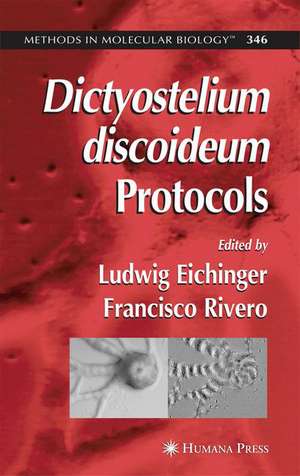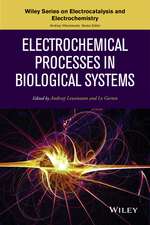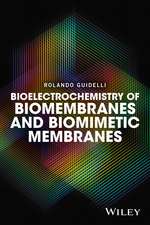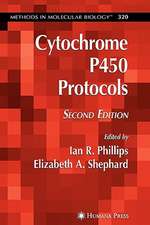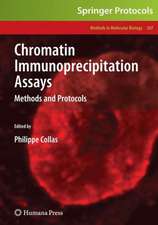Dictyostelium discoideum Protocols: Methods in Molecular Biology, cartea 346
Editat de Ludwig Eichingeren Limba Engleză Hardback – iul 2006
| Toate formatele și edițiile | Preț | Express |
|---|---|---|
| Paperback (1) | 1231.64 lei 43-57 zile | |
| Humana Press Inc. – 19 noi 2010 | 1231.64 lei 43-57 zile | |
| Hardback (1) | 1237.80 lei 43-57 zile | |
| Humana Press Inc. – iul 2006 | 1237.80 lei 43-57 zile |
Din seria Methods in Molecular Biology
- 9%
 Preț: 791.59 lei
Preț: 791.59 lei - 23%
 Preț: 598.56 lei
Preț: 598.56 lei - 20%
 Preț: 882.95 lei
Preț: 882.95 lei -
 Preț: 252.04 lei
Preț: 252.04 lei - 5%
 Preț: 802.69 lei
Preț: 802.69 lei - 5%
 Preț: 729.61 lei
Preț: 729.61 lei - 5%
 Preț: 731.43 lei
Preț: 731.43 lei - 5%
 Preț: 741.30 lei
Preț: 741.30 lei - 5%
 Preț: 747.16 lei
Preț: 747.16 lei - 15%
 Preț: 663.45 lei
Preț: 663.45 lei - 18%
 Preț: 1025.34 lei
Preț: 1025.34 lei - 5%
 Preț: 734.57 lei
Preț: 734.57 lei - 18%
 Preț: 914.20 lei
Preț: 914.20 lei - 15%
 Preț: 664.61 lei
Preț: 664.61 lei - 15%
 Preț: 654.12 lei
Preț: 654.12 lei - 18%
 Preț: 1414.74 lei
Preț: 1414.74 lei - 5%
 Preț: 742.60 lei
Preț: 742.60 lei - 20%
 Preț: 821.63 lei
Preț: 821.63 lei - 18%
 Preț: 972.30 lei
Preț: 972.30 lei - 15%
 Preț: 660.49 lei
Preț: 660.49 lei - 5%
 Preț: 738.41 lei
Preț: 738.41 lei - 18%
 Preț: 984.92 lei
Preț: 984.92 lei - 5%
 Preț: 733.29 lei
Preț: 733.29 lei -
 Preț: 392.58 lei
Preț: 392.58 lei - 5%
 Preț: 746.26 lei
Preț: 746.26 lei - 18%
 Preț: 962.66 lei
Preț: 962.66 lei - 23%
 Preț: 860.21 lei
Preț: 860.21 lei - 15%
 Preț: 652.64 lei
Preț: 652.64 lei - 5%
 Preț: 1055.50 lei
Preț: 1055.50 lei - 23%
 Preț: 883.85 lei
Preț: 883.85 lei - 19%
 Preț: 491.88 lei
Preț: 491.88 lei - 5%
 Preț: 1038.84 lei
Preț: 1038.84 lei - 5%
 Preț: 524.15 lei
Preț: 524.15 lei - 18%
 Preț: 2122.34 lei
Preț: 2122.34 lei - 5%
 Preț: 1299.23 lei
Preț: 1299.23 lei - 5%
 Preț: 1339.10 lei
Preț: 1339.10 lei - 18%
 Preț: 1390.26 lei
Preț: 1390.26 lei - 18%
 Preț: 1395.63 lei
Preț: 1395.63 lei - 18%
 Preț: 1129.65 lei
Preț: 1129.65 lei - 18%
 Preț: 1408.26 lei
Preț: 1408.26 lei - 18%
 Preț: 1124.92 lei
Preț: 1124.92 lei - 18%
 Preț: 966.27 lei
Preț: 966.27 lei - 5%
 Preț: 1299.99 lei
Preț: 1299.99 lei - 5%
 Preț: 1108.51 lei
Preț: 1108.51 lei - 5%
 Preț: 983.72 lei
Preț: 983.72 lei - 5%
 Preț: 728.16 lei
Preț: 728.16 lei - 18%
 Preț: 1118.62 lei
Preț: 1118.62 lei - 18%
 Preț: 955.25 lei
Preț: 955.25 lei - 5%
 Preț: 1035.60 lei
Preț: 1035.60 lei - 18%
 Preț: 1400.35 lei
Preț: 1400.35 lei
Preț: 1237.80 lei
Preț vechi: 1509.51 lei
-18% Nou
Puncte Express: 1857
Preț estimativ în valută:
236.86€ • 247.92$ • 197.14£
236.86€ • 247.92$ • 197.14£
Carte tipărită la comandă
Livrare economică 31 martie-14 aprilie
Preluare comenzi: 021 569.72.76
Specificații
ISBN-13: 9781588296238
ISBN-10: 1588296237
Pagini: 564
Ilustrații: XVI, 564 p. 186 illus.
Dimensiuni: 152 x 229 x 37 mm
Greutate: 1.02 kg
Ediția:2006
Editura: Humana Press Inc.
Colecția Humana
Seria Methods in Molecular Biology
Locul publicării:Totowa, NJ, United States
ISBN-10: 1588296237
Pagini: 564
Ilustrații: XVI, 564 p. 186 illus.
Dimensiuni: 152 x 229 x 37 mm
Greutate: 1.02 kg
Ediția:2006
Editura: Humana Press Inc.
Colecția Humana
Seria Methods in Molecular Biology
Locul publicării:Totowa, NJ, United States
Public țintă
ResearchCuprins
The Organism, Community Resources, and Genome-wide Studies.- The Secret Lives of Dictyostelium.- The Genome of Dictyostelium discoideum.- The cDNA Sequencing Project.- dictyBase and the Dicty Stock Center.- Analysis of Gene Expression Using cDNA Microarrays.- Proteomic Analysis of Dictyostelium discoideum.- Basic Methods and Molecular Genetic Techniques.- Cultivation, Spore Production, and Mating.- Parasexual Genetics Using Axenic Cells.- Slug Phototaxis, Thermotaxis, and Spontaneous Turning Behavior.- Purification Techniques of Subcellular Compartments for Analytical and Preparative Purposes.- Generation of Multiple Knockout Mutants Using the Cre-loxP System.- Restriction Enzyme-Mediated Integration (REMI) Mutagenesis.- RNA Interference and Antisense-Mediated Gene Silencing in Dictyostelium.- Imaging and Localization Methods.- Application of Fluorescent Protein Tags as Reporters in Live-Cell Imaging Studies.- Investigating Gene Expression.- Application of 2D and 3D DIAS to Motion Analysis of Live Cells in Transmission and Confocal Microscopy Imaging.- Using Quantitative Fluorescence Microscopy and FRET Imaging to Measure Spatiotemporal Signaling Events in Single Living Cells.- Visualizing Signaling and Cell Movement During the Multicellular Stages of Dictyostelium Development.- Under-Agarose Chemotaxis of Dictyostelium discoideum.- Optimized Fixation and Immunofluorescence Staining Methods for Dictyostelium Cells.- Cryofixation Methods for Ultrastructural Studies of Dictyostelium discoideum.- Dictyostelium as Model Organism.- Analysis of Signal Transduction.- Assaying Chemotaxis of Dictyostelium Cells.- Characterization of Cross-Linked Actin Filament Gels and Bundles Using Birefringence and Polarized Light Scattering.- Quantitative and Microscopic Methods for Studyingthe Endocytic Pathway.- Preparation of Intact, Highly Purified Phagosomes from Dictyostelium.- Assaying Cell-Cell Adhesion.- Periodic Activation of ERK2 and Partial Involvement of G Protein in ERK2 Activation by cAMP in Dictyostelium Cells.- An Improved Method for Dictyostelium Centrosome Isolation.- Epiggenetics in Dictyostelium.- Dictyostelium discoideum as a Model to Study Host-Pathogen Interactions.- Pharmacogenetics.- How to Assess and Study Cell Death in Dictyostelium discoideum.
Textul de pe ultima copertă
Dictyostelium discoideum Protocols presents a comprehensive collection of cutting-edge molecular biological protocols for studying D. discoideum, with emphasis on its utility in the study of fundamental cellular processes including signal transduction, chemotaxis, cell motility, cytokinesis, phagocytosis, and aspects of development such as cell sorting, pattern formation, and cell type differentiation. Written by experts in the field, this important guide provides easy access to current methods and techniques for the study of D. discoideum. For the newcomer to the field, it offers a complete and inclusive introduction to this important model organism. The book is divided into four main parts, which include an introduction to the organism that provides integral community resources and genome-wide approaches; basic methods and available molecular genetic techniques for study of the organism; imaging and localization methods; and a discussion of D. discoideum, with emphasis on its unique advantages as a model system.
This in-depth guide provides a complete introduction to and thorough handbook for the study of D. discoideum, including a discussion of the implications of the recently completed Dictyostelium genome project in strengthening the position of D. discoideum as a model organism for studying fundamental cell processes and aspects of development. Researchers at all levels of experience will benefit from the presentations throughout of the most current, useful, and innovative techniques for the study of D. discoideum from leading Dictyostelium scientists.
This in-depth guide provides a complete introduction to and thorough handbook for the study of D. discoideum, including a discussion of the implications of the recently completed Dictyostelium genome project in strengthening the position of D. discoideum as a model organism for studying fundamental cell processes and aspects of development. Researchers at all levels of experience will benefit from the presentations throughout of the most current, useful, and innovative techniques for the study of D. discoideum from leading Dictyostelium scientists.
Caracteristici
Includes supplementary material: sn.pub/extras
